Most people love the idea of baking with sourdough because they see pictures of beautiful artisan loaves with deep crust, slashes, and all the rest. And then the reality of their bread is a flat, weird situation that is not quite what they expected. Anyone else?
It’s time to end that sadness forever. Because once you master this bread machine sourdough recipe, you’ll have a foolproof loaf you’ll be proud of every time.
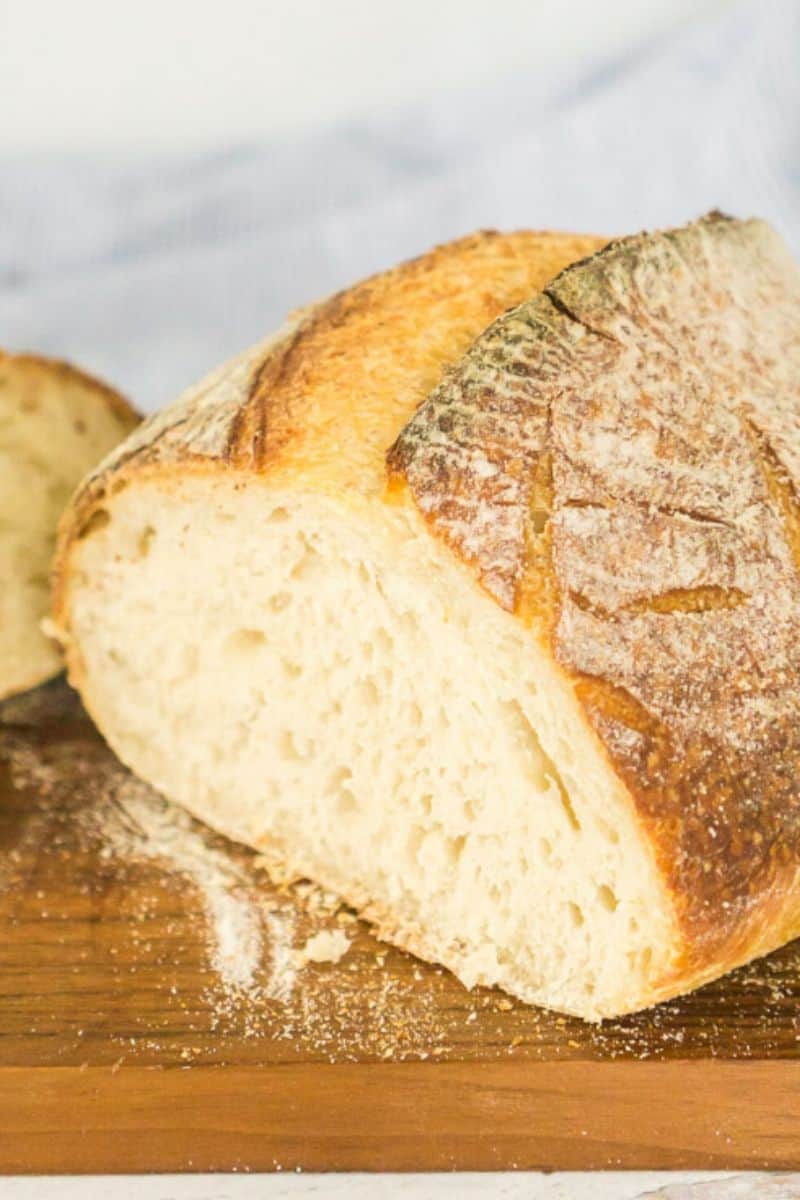
Over time, this has become my go-to for daily baking. It’s incredibly easy, especially since my bread machine handles most of the kneading. With just a few basic ingredients and letting the dough rise overnight in the fridge, I always end up with a crispy loaf on the outside and soft and chewy inside.
It’s perfect for sandwiches, toast, or even just a buttered slice. At first, the dough might seem a bit dry, but I’ve learned that’s completely normal. Resist the urge to add extra water and trust the process, and it turns out perfectly every time.
Ingredients and Tools You’ll Need
We’re using the bread machine to do the kneading, but you can also do it in a stand mixer. Make sure your starter is bubbly and active.

Get a Free + Pretty PDF Recipe Book
Sourdough Sunday Newsletter

Every Sunday evening I’ll send you a sourdough recipe to make that week, straight from my kitchen to your inbox.
And as a thank you for signing up, I’ll send you this e-book with beautiful printable recipes right away. Simple!
You will not be added to any other email lists or my daily newsletter. But if you’re already on my newsletter, you’re welcome to join and receive both.
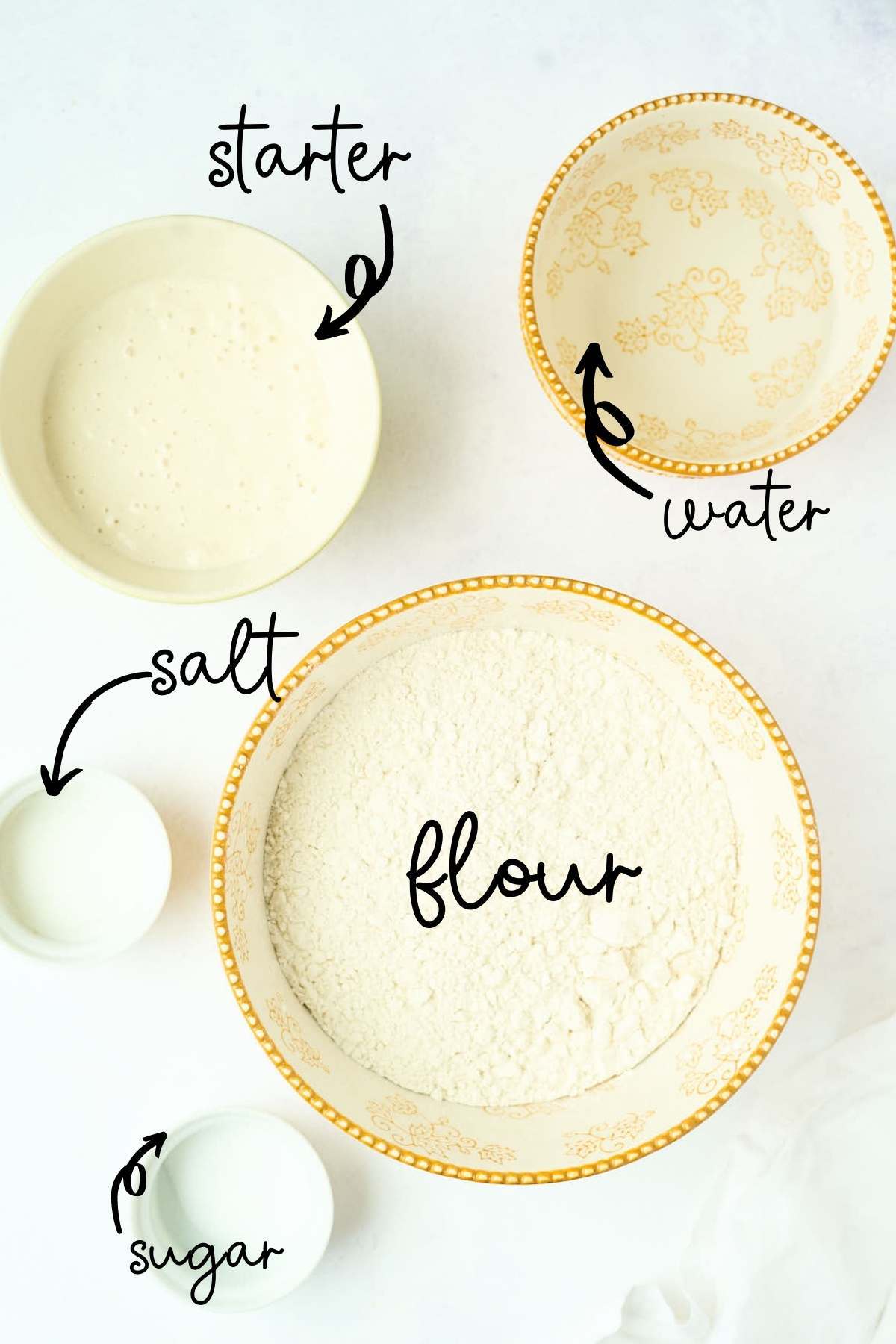
Heart’s Content Farmhouse is a participant in the Amazon Services LLC Associates Program, an affiliate advertising program designed to provide a means for sites to earn advertising fees by advertising and linking to Amazon.com. This means that when you click on certain links on this site and make a purchase, I may earn a small commission at no additional cost to you. I only recommend products I genuinely believe in and would use in my own kitchen. As an Amazon Associate, I earn from qualifying purchases.
Equipment
- Bread machine (with a dough cycle setting) (It does the kneading for you. If you don’t have one, kneading by hand or using a mixer works, but a bread machine simplifies the process.)
- Large mixing bowl
- Measuring cups and spoons
- Damp tea towel or kitchen towel
- Baking Sheet
- Parchment paper
- Rimmed baking sheet
Ingredients
- 3 cups bread flour (15.85 ounces) (regular or wheat flour will work too, but bread flour will make your bread chewier and stronger)
- 1 cup lukewarm water (7.75 ounces)
- ¾ cup fed sourdough starter (5.65 ounces) (You can also easily make your own at home with flour and water—it takes about 5-7 days to get a strong starter going.)
- ½ tablespoon sugar
- 1 ¾ teaspoon salt
How to Make Bread Machine Sourdough
Step One: Autolyze
Combine the bread flour, sourdough starter, sugar, and water in a large mixing bowl. The dough will feel drier than typical sourdough—this is normal. Do not add more water. Use your hands to make sure all ingredients are incorporated into a cohesive ball. Cover the bowl with a damp tea towel and let the dough rest on the counter for 30 minutes. Tip: Pre-measure the salt and place it in a small container on the towel to remind yourself to add it later.
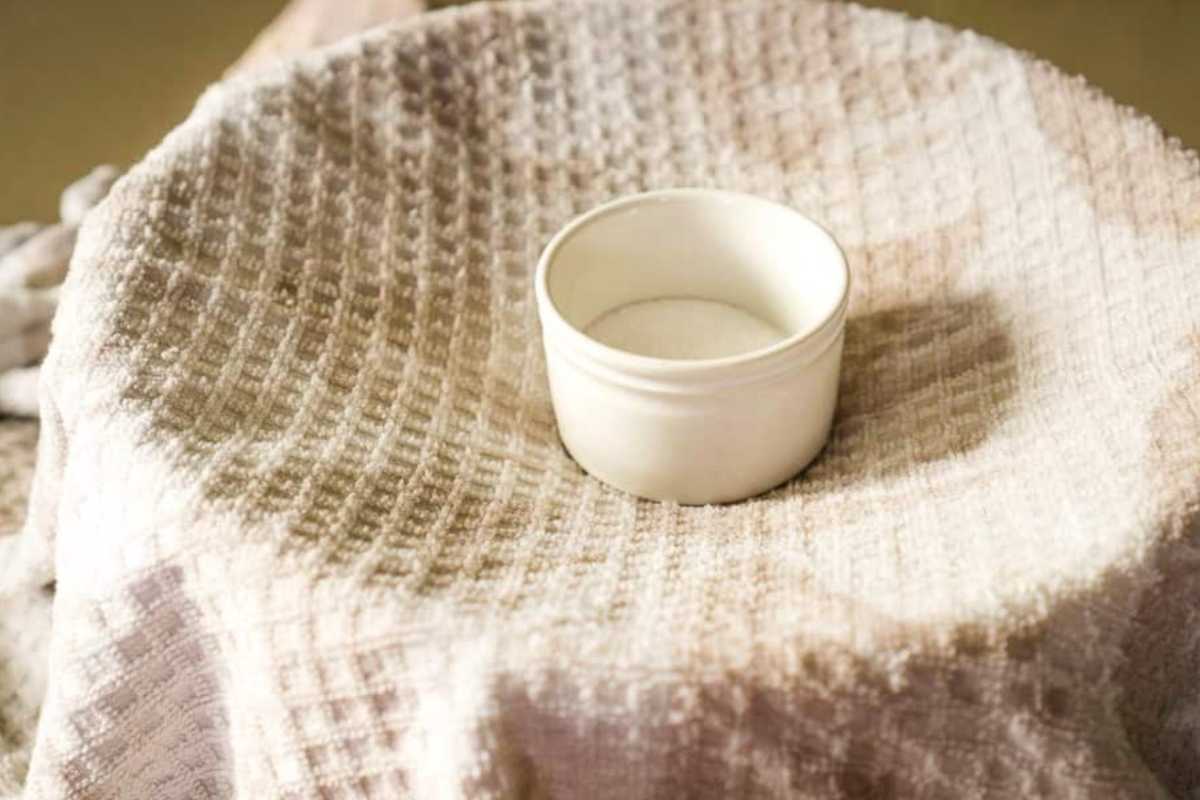
Step Two: Knead
After the autolyze, transfer the dough and salt into the bread machine bucket. Then, select the “dough” cycle and press start. You don’t need to fold the dough or anything crazy like that. Just walk away.
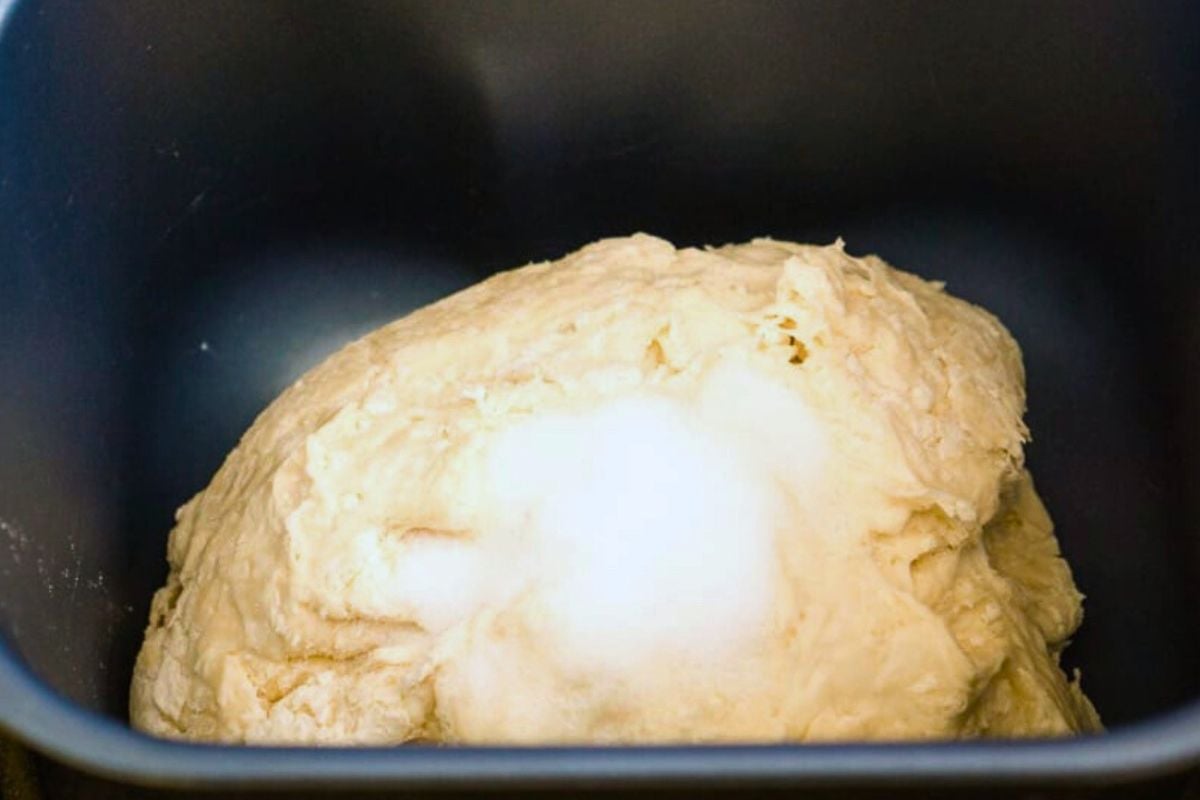
Step Three: First Rise
When the cycle ends, leave the dough in the machine to continue rising for 2-3 more hours. The dough should be noticeably puffier and soft to the touch, though it may not have doubled in size. This longer rise helps develop the flavor and texture of the bread.
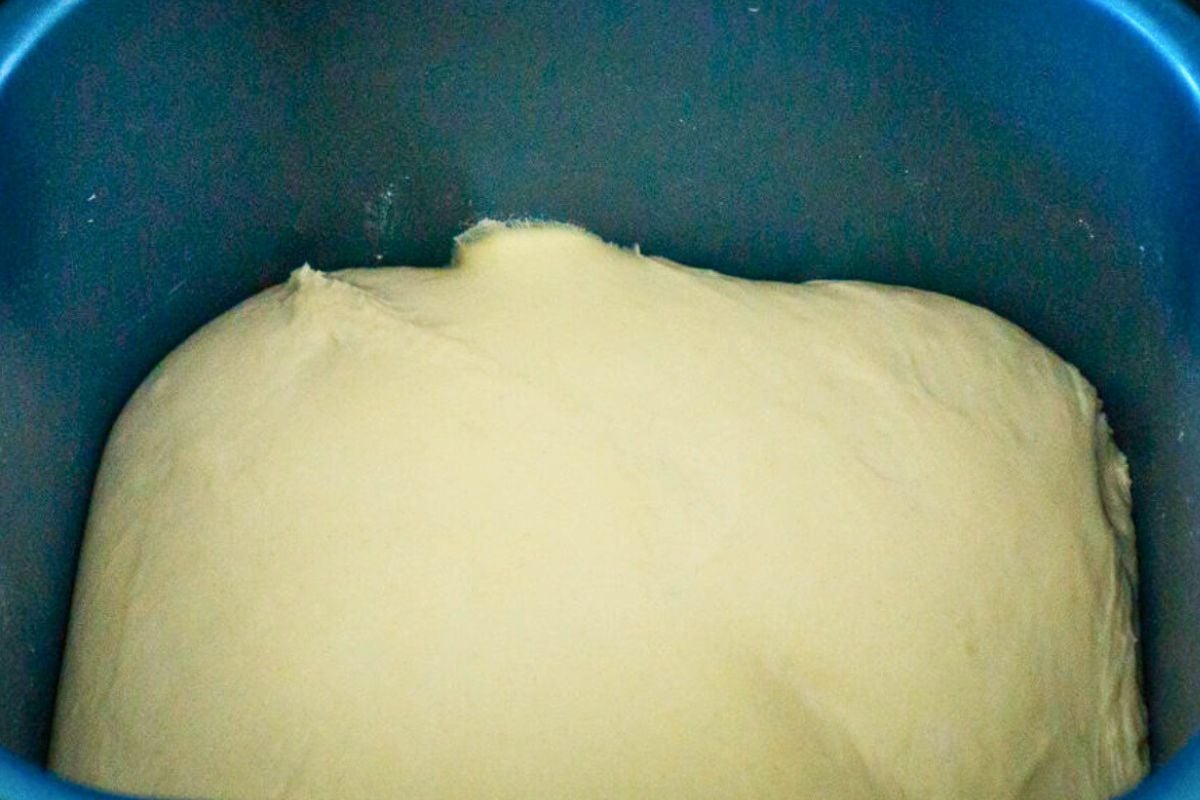
Step Four: Shape The Loaf
Prepare a baking sheet by lining it with parchment paper and sprinkling cornmeal over the surface. Carefully remove the dough from the bread machine and gently shape it into a round or oval loaf. The dough will be slightly sticky, but avoid using flour for shaping. Place the dough on the prepared baking sheet.
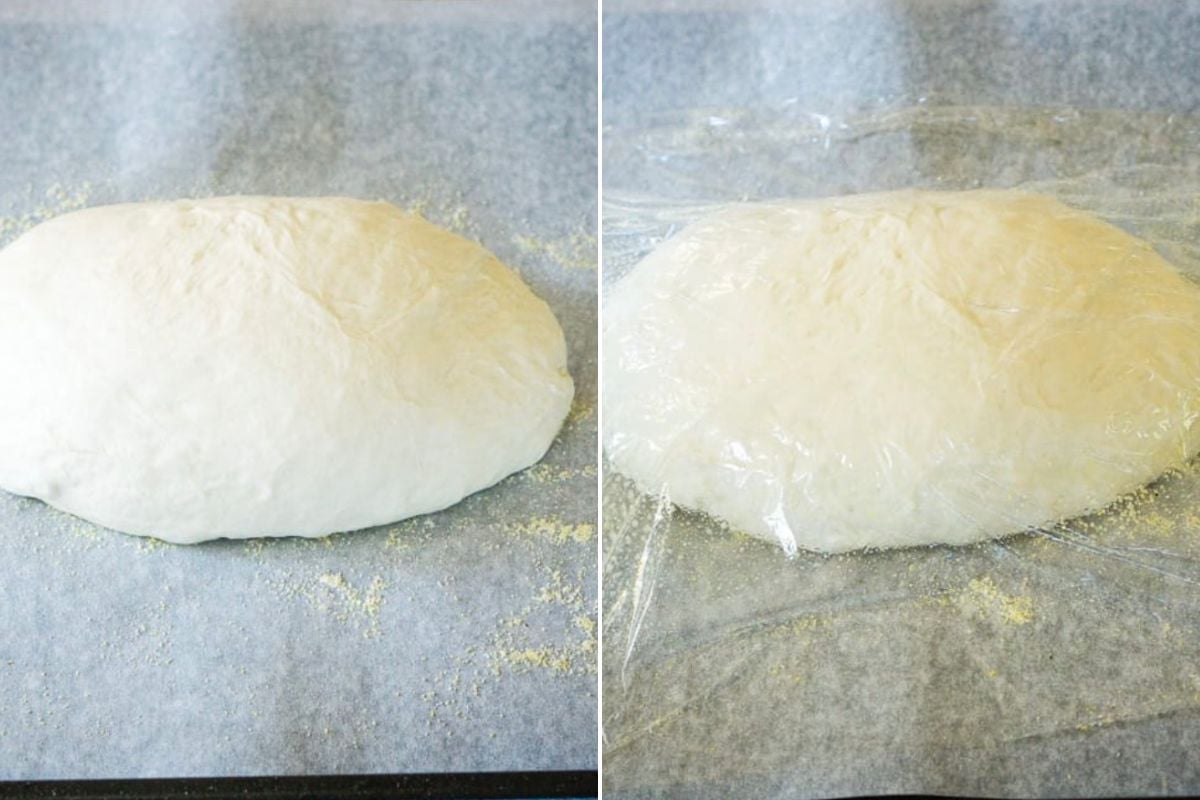
Step Five: Second Rise (Overnight Proof)
Spray a piece of plastic wrap with cooking spray and loosely cover the shaped dough. Place the covered loaf in the refrigerator to proof overnight for 8 to 16 hours.
Step Six: Prep For Baking
In the morning, preheat the oven to 450°F (230°C). Position two racks: one in the center of the oven and the other in the lower middle. Then, place an empty-rimmed baking sheet on the lower rack while the oven is preheating. Next, remove the loaf from the fridge. Dust it lightly with flour and use a lame or a sharp serrated knife to slash the top of the dough, allowing the loaf to expand during baking.
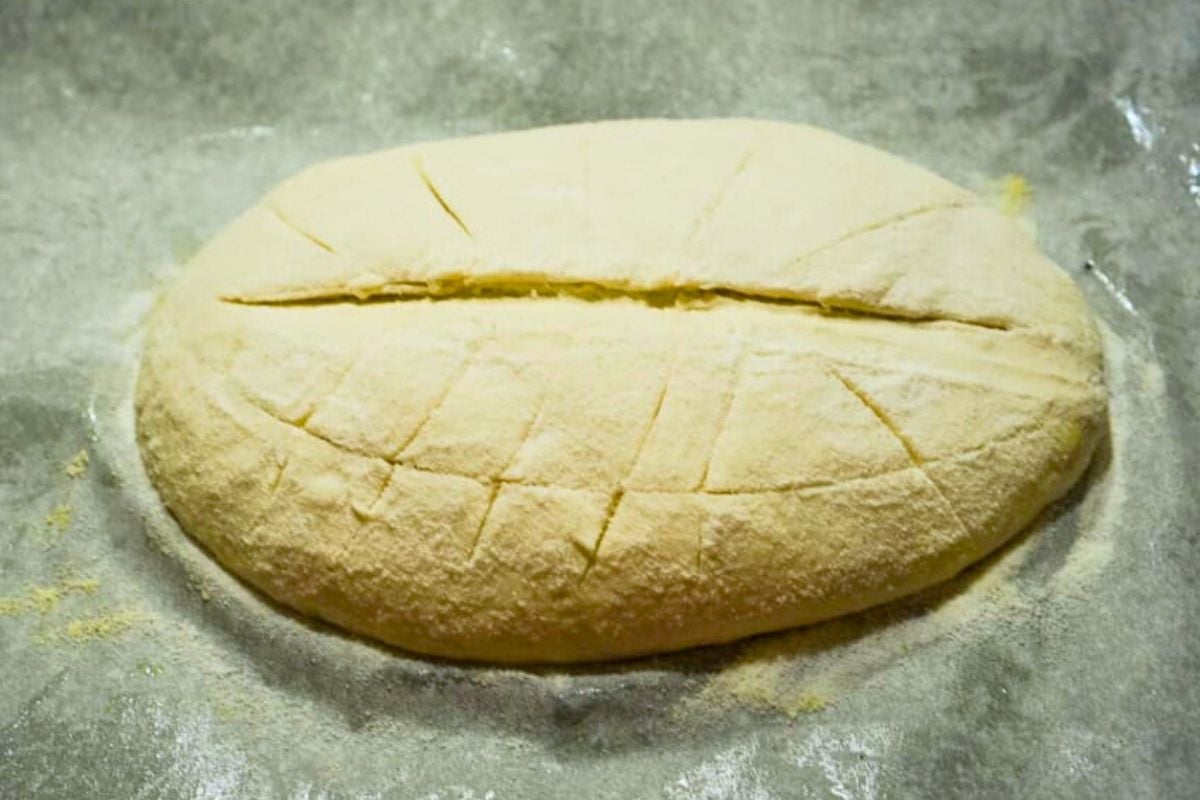
Step Seven: Bake With Steam
When the oven is fully preheated, carefully pour 1 cup of water into the baking sheet on the lower rack to create steam. Immediately place the loaf on the center rack and close the oven door. Bake the loaf for 45 minutes until it reaches a deep golden-brown color. Remove from the oven and allow the bread to cool on a wire rack for at least 4 hours.
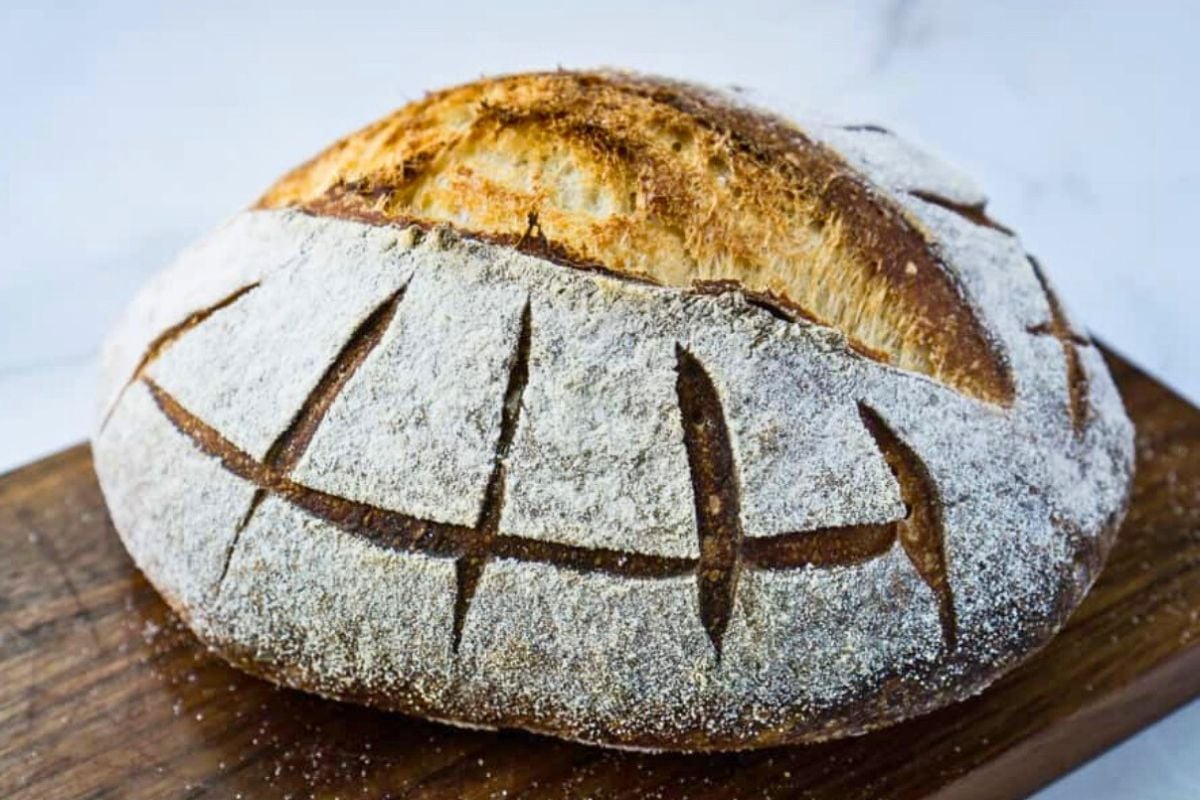
Step Eight: Slice And Serve
Once the bread has fully cooled (after at least 4 hours), use a sharp, serrated knife to slice the loaf into even pieces. Enjoy fresh or toasted with your favorite toppings!
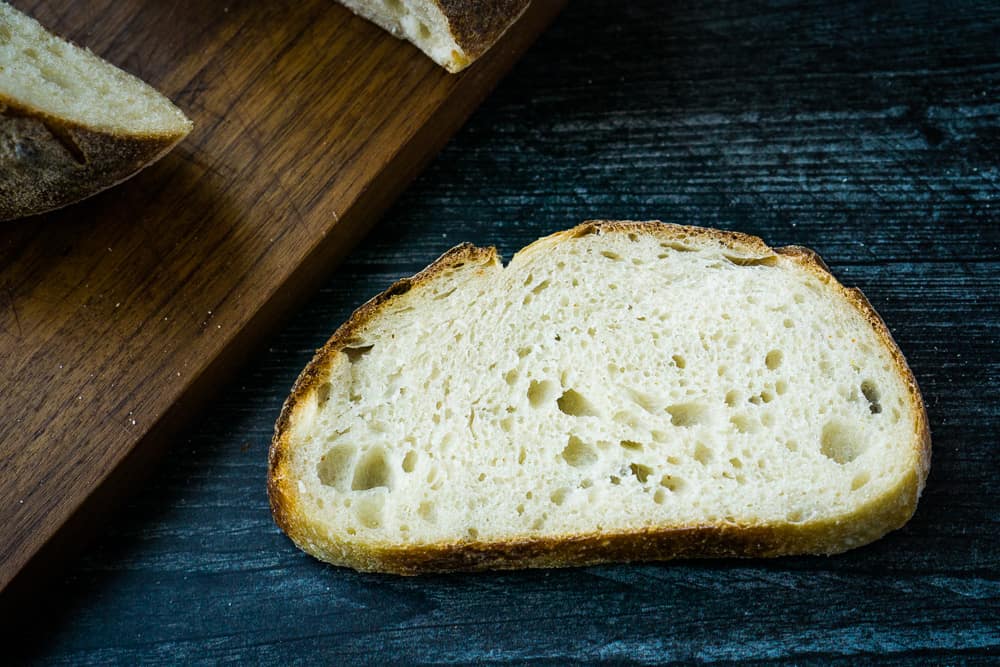
Storage Instructions
Once the bread has completely cooled, wrap it in a clean kitchen towel or place it in a paper bag. This will help keep the crust crispy while preventing the bread from drying. Avoid using plastic, as it can cause the crust to become soft. Stored this way, the bread will stay fresh for about 3 days at room temperature.
You can also freeze it. First, let the loaf cool completely. Then, slice the bread into pieces, so it’s easier to use later. Wrap the slices tightly in plastic wrap or aluminum foil and place them in a freezer-safe bag. Remove as much air as possible before sealing the bag. The bread can be stored in the freezer for up to 1 month.
Thaw the slices at room temperature or pop them straight into the toaster. You can also reheat them in the oven for a few minutes to freshen up the crust.
What to Serve with Bread Machine Sourdough Bread
This bread is great for everything from toast at breakfast to a side at dinner.
- Spread on some homemade butter or strawberry jam.
- It’s great for grilled cheese sandwiches since it doesn’t have big holes.
- Serve as a side for dinner, like with a creamy chicken noodle soup.
Questions and Troubleshooting
Check my Sourdough FAQ page to see what could have gone wrong.
The autolyze step helps improve the dough’s texture, but if you’re short on time, you can throw everything in the bread machine and still get a great loaf.
No! It’s normal for this particular recipe. Once it rests and rises, the dough will soften and be easier to work with.
Great question! The dough should look noticeably puffier, but doesn’t need to double in size. If you press it gently with a finger and it springs back slowly, it’s ready.
Yes, you can! If you’re in a rush, let the dough rise at room temperature for another 2-3 hours. The slow, overnight rise helps develop the sourdough flavor, so try it when you can.
There are a couple of reasons this could happen. If your starter wasn’t bubbly and active when you used it, that could slow the rise. Also, sourdough can be slightly slow to rise, especially in cooler kitchens. If this happens, just give it more time to puff up! If you’re having trouble with your sourdough starter and wondering if it’s still alive, don’t worry! Check out this helpful guide on how to tell if you’ve killed your sourdough starter.
Yes! Some readers have baked this in the machine. But you can’t just run a cycle from start to finish. You’ll need to remove the dough to rest in the fridge overnight, then pop it back in to bake in the morning.
You sure can. The steam and baking sheet is really a workaround for those of us who don’t have one. 😊
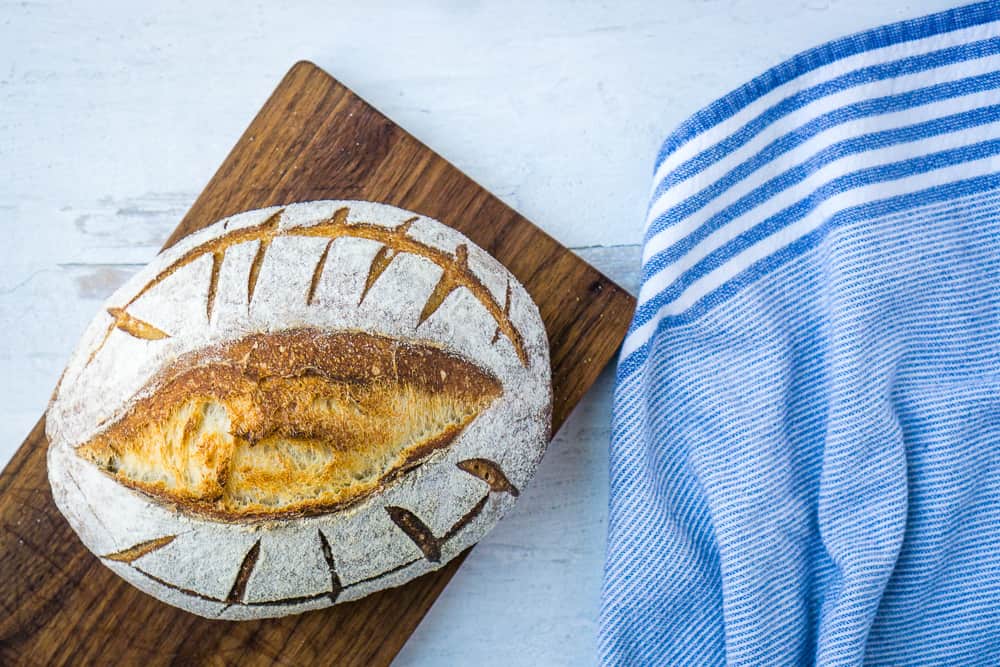
More Sourdough Recipes For Beginners
- My sourdough roll recipe uses the same steam technique and adds a pinch of instant yeast for a fluffy roll with a crisp crust.
- Sourdough baguettes are hand kneaded but also a similar process.
- And if you want to do all the crazy folding and buy some neat tools, here is a true artisan bread recipe you might like.
Printable Recipe

Bread Machine Sourdough
Equipment
- Bread machine (with a dough cycle setting)
- Large mixing bowl
- Measuring cups and spoons
- Damp tea towel or kitchen towel
- Baking Sheet
- Rimmed baking sheet
Ingredients
- 3 cups bread flour (15.85 ounces)
- 1 cup lukewarm water (7.75 ounces)
- ¾ cup fed sourdough starter (5.65 ounces)
- ½ tablespoon sugar
- 1 ¾ teaspoon salt
Save This Recipe
You'll join my email list which you will love. And if you don't, unsubscribe in one click. ❤️
Instructions
- Autolyze. Combine the bread flour, sourdough starter, sugar, and water in a large mixing bowl. The dough will feel drier than typical sourdough—this is normal. Do not add more water. Use your hands to make sure all ingredients are incorporated into a cohesive ball. Cover the bowl with a damp tea towel and let the dough rest on the counter for 30 minutes.Tip: Pre-measure the salt and place it in a small container on the towel to remind yourself to add it later.
- Knead. After the autolyze, transfer the dough and salt into the bread machine bucket. Then, select the “dough” cycle and press start. You don’t need to fold the dough or anything crazy like that. Just walk away.
- First rise. When the cycle ends, leave the dough in the machine to continue rising for 2-3 more hours. The dough should be noticeably puffier and soft to the touch, though it may not have doubled in size. This longer rise helps develop the flavor and texture of the bread.
- Shape the loaf. Prepare a baking sheet by lining it with parchment paper and sprinkling cornmeal over the surface. Carefully remove the dough from the bread machine and gently shape it into a round or oval loaf. The dough will be slightly sticky, but avoid using flour for shaping. Place the dough on the prepared baking sheet.
- Second Rise (overnight proof). Spray a piece of plastic wrap with cooking spray and loosely cover the shaped dough. Place the covered loaf in the refrigerator to proof overnight for 8 to 16 hours.
- Prep for baking. In the morning, preheat the oven to 450°F (230°C). Position two racks: one in the center of the oven and the other in the lower middle. Then, place an empty-rimmed baking sheet on the lower rack while the oven is preheating. Next, remove the loaf from the fridge. Dust it lightly with flour and use a lame or a sharp serrated knife to slash the top of the dough, allowing the loaf to expand during baking.
- Bake with steam. When the oven is fully preheated, carefully pour 1 cup of water into the baking sheet on the lower rack to create steam. Immediately place the loaf on the center rack and close the oven door. Bake the loaf for 45 minutes until it reaches a deep golden-brown color. Remove from the oven and allow the bread to cool on a wire rack for at least 4 hours.
- Slice and serve. Once the bread has fully cooled (after at least 4 hours), use a sharp, serrated knife to slice the loaf into even pieces. Enjoy fresh or toasted with your favorite toppings!
Video
Notes
Nutrition


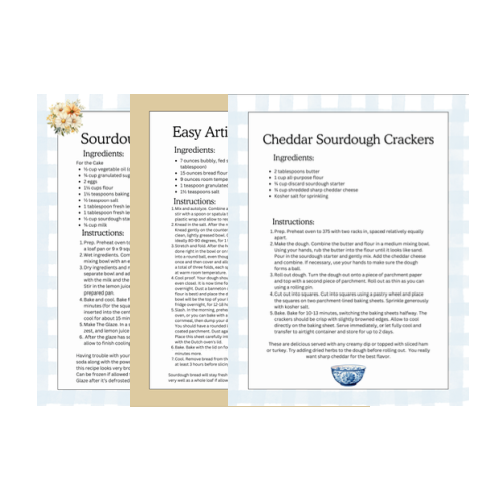

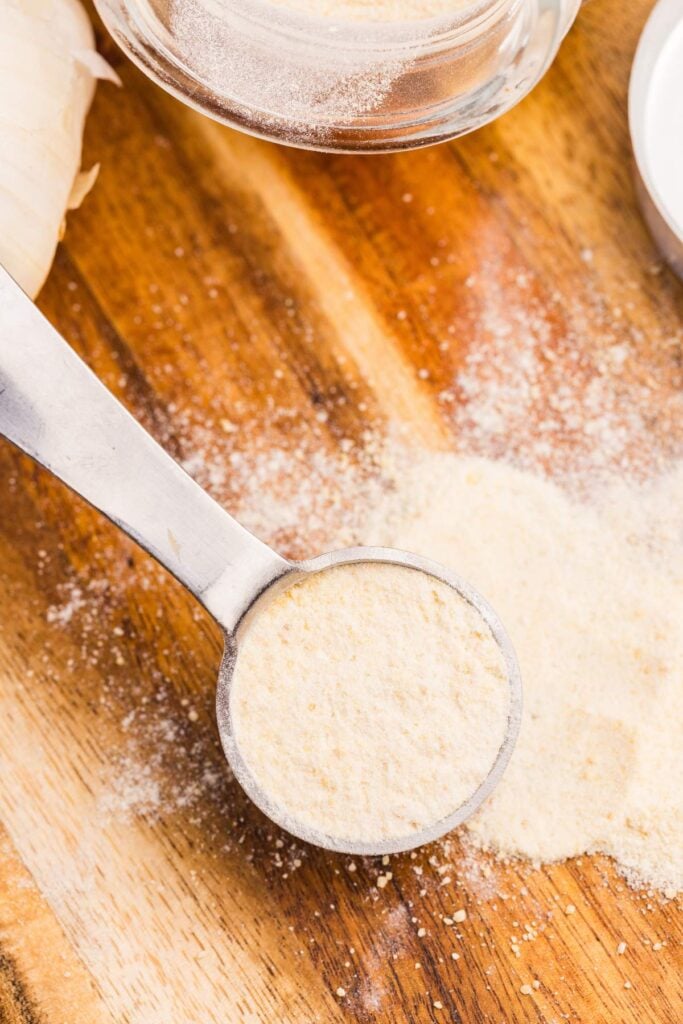


Hi Katie. Thank you for this recipe I will try to make it today. I have not had any success with sourdough bread yet. I have been trying to make a great starter for 2 months. Hopefully the last try will be ready today. My question is, can I freeze it for a day before baking it? I am taking it to my daughters cottage tomorrow, so I have to make it today, but we won’t bake it until two days from now.
connie, I have never had any luck freezing any type of sourdough dough. the best plan would be to bake, let it fully cool and then freeze the finished loaf. or make the dough, shape, put it in the fridge and keep it refrigerated for some extra time.
Fantastic Recipe! I hate it when people say how the recipe was perfect and then go on to show you how they changed it…but I’m going to be that person 🙂 I used the recipe as written but made the following “tweaks” in cooking that worked well for me. Twice so far!
1. I mixed all the ingredients except salt in my stand mixer before letting them rest. I have carpal tunnel, so this is much easier on my hands.
2. I baked on parchment in a dutch oven so no need for messing with the steam. I put my dutch oven in the oven when I preheated so it was to temperature when I put the loaf in. I cooked it at 450 degrees for 17 minutes (I have a convection oven so things tend to go a bit faster for me) and then removed the lid.
3. I inserted a probe thermometer into the bread and cooked it to 200 degrees inside, removed and let rest for 4+ hours.
PERFECTION!
You’ve made sourdough a reality for my family on a regular basis now! With the dough and first rise in the bread machine, it makes it easy to work around my schedule. Thank you so much!!! I’m looking forward to many happy loaves!
marcy that is so funny! your changes are great. it does work well in a Dutch Oven!
Thanks for sharing this recipe. My results have been outstanding. Works with light and dark rye flours too.
It’s so easy – just as long as I remember to plan far enough in advance!
I’ve struggled before now, but it’s sooooo good to have a recipe that just works.
Thank you again
so glad to hear that Andrew ????
Never made sourdough before and this recipe comes out great! I’ve made it several times. I normally don’t make that deep a cut across the top. Does it help to do that?
Sharon it just helps to give your loaf an “ear” where it sort of rises up. just for looks 🙂
Katie
To fill you in a little on my first success…….I used the french dough cycle (3h35) instead of the usual of 2h20. It was too late at night to take out of the machine and put on a tray in the fridge so I left it all night in the machine. This morning I took it out, shaped it on a tray and baked with no further resting. Excellent result! Would it have been even better if it had been in the fridge overnight instead of the machine?
My first success with sourdough. First time I used your method and recipe and it worked brilliantly. Thank you.
you are so welcome! I truly believe this method succeeds when others fail!
I have been baking sourdough bread using this recipe once or twice a week. I knew it was gonna happen one time that I forget to put the paddle in the bucket. Multitasking. I realized when I was washing the bucket after the first 3 hr rise ( the dough looked different too). I decided to proceed and see what happens. I also did not wait for the 4 hrs before cutting the bread. The bread did not rise as much and the sourdough taste was not there. I assume lack of rising is due to improper kneading, lack of sourdough taste is due to not waiting the 4 hrs?
It will notahppen again.
My next sourdough bread is with roasted garlic and rosemary, which will be added when the dough cycle beeps for add ins.
BTW, have not tried any other recipe.. no need as this one is highly recommended.
gemma I’ve done that too! it not rising makes sense to me but I wonder why it didn’t have the same flavor? anyway, know that everyone has a sourdough bread snafu now and then! hope the garlic and rosemary version goes well!
Really great recipe and a lot less complicated than the artisan recipe someone gave me, but the taste and texture are almost identical. It’s also pretty forgiving. I’m at high altitude and add less flour and then eyeball it for the right texture of dough and it has never been a problem. Don’t use a scale either.
so happy you liked it ivy! I’m not sure why so many people think complicated sourdough methods are the best! ????
Hi!
I would like to make sourdough bread bowls and use this recipe. Can you recommend how to multiply and/or split this recipe to make 6 bowls? I know I shouldn’t try to stick double the recipe in the machine so I will do it twice or three times or however many. Just not sure how big the results of this are.
Wendy you could double the recipe in the machine. it doesn’t come halfway up the bucket when it rises so I think it will be fine. that should be enough for 6 bread bowls
Thanks! I will definitely be trying this!
I made this several times and each time worked out better,except this time. I noticed as it was in the fridge it was not rising smoothly. It had cracks in the loaf. Left overnight and it didn’t rise much. Baked it and sliced after it cooled. Tasted favourable but heavy. Any ideas what went wrong? Somewhat disappointed as my daughter requested a loaf to take to the lake for her weeks vacation.
patricia, sometimes it just happens that a loaf doesn’t turn out as well and there’s no real reason. it could be that as the humidity increased your flour absorbed more water in storage. did the dough seem very sticky s you were handling it? the other explanation is your starter wasn’t as well fed as its been in the past.
This recipe works. It’s easy to follow and execute.
I make a slightly smaller 300g loaf and it works every single time.
A sourdough loaf without fuss. Hooray.
My bread machine’s dough cycle has a half hour pause before it starts kneading so I’ve been able to cut out the ’30 minute counter rest’ by putting the mixed dough straight into one side of the dough bucket and adding the salt to the other side. I then select the dough cycle program and leave it alone for 6 or 7 hours before the, tip it out and stick it in the fridge stage. Brilliant.
Thank you for including grams in your measurements as well as cups and pounds and ounces.
It makes life so much easier than converting all the time.
hi lorraine! I’m so happy to hear that it’s working well, and I love the tip about the smaller loaf, as I’d like to try that too! happy I could simplify your sourdough life 🙂
I have been making my own bread with a bread machine for years using only the dough cycle and shaping it in my loaf pan for the final rise, but these days bread flour and yeast are hard to find (at least in my town it is). So I thought about making sourdough bread with a starter, and getting away from yeast and bread flour until “things” hopefully get back to normal. Your recipe is the easiest and close to what I have been looking for but I have a few questions. When shaping the bread, can I us my loaf pan? And can I use regular flour?
christine, this really does better on a baking sheet so it can puff up in the oven. all purpose flour is fine but you’ll need to reduce the water considerably, about 20%. they absorb water at very different amounts 🙂
Great recipe! Love the incorporation of the bread machine with a nice overnight bake.
Definitely five stars. I tried two other sourdough recipes before I found yours. I’m so glad I did! Thank you for your clear directions also. My family LOVES this bread. A round of applause for my first sourdough starter, Althea.
hooray! so glad it worked out well for you! glad you found it too 🙂
How doyou make the starter for the bread
Brenda, search my site for sourdough starter and you’ll find detailed instructions for starting one and for maintaining it 🙂
Hi Katie,
Thank you for your reply, the bread still tastes great so definitely going to try it with 1/4 wholemeal flour next time! Thanks again
Hi, I’m not a baker and we’ve tried a few different recipes but this one is spot on! The bread tastes awesome! Thank you for posting this recipe.
I thought I’d try the recipe with wholemeal bread flour instead and it didn’t rise as much, definitely more stodgy and the bottom feels uncooked. Any thoughts on what I could tweak to make the wholemeal version as good?
It’s just a trickier flour to get a good result with. You can try adding a little more water, letting it rise longer, or backing off and doing just 1/4 whole wheat then increasing the amount from there. until you find your limit.
Hi Katie! Why not preparing the dough and letting it autolyse in the mixer? Have you had any inconvenient with that? I already have experience on sourdough bread but never used the machine for mixing and kneading. Great recipe!!
hi Juan, you definitely could do that, I just don’t like to deal with my mixer unless have I to, it’s sort of a pain
Hi there! Thanks for putting this out there. After the bread has been shaped to I have ti refrigerate it? Is there an amount of time I can leave it on the counter and then bake it ?
thanks
Tess
you can experiment with another room temperature rise, about 3 hours, but this will vary a LOT depending on the temperature of your room.. I just like the overnight fridge method because there’s no risk of over proofing and it develops flavor.
I too suffered from the ‘flat, weird situation’ time and time again. This recipe is fantastic. I make my usual yeast bread by bread-maker so this was easy for me. Beautiful loaf with just the right texture. Now eating it toasted on the second day. Glorious. Thank you very much from a happy bread baker in Tasmania
caz I am so happy you found sourdough success!